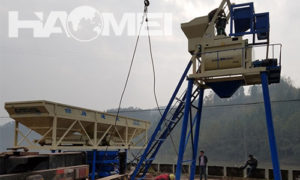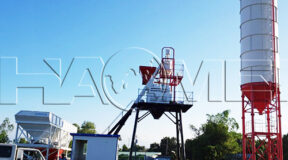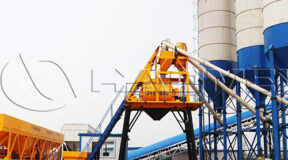Components of ready mix concrete plant include 5 major systems: material storage system, material weighing system, material conveying system, mixing system, powder storage system, powder conveying system, powder measuring system, water and admixture measuring system and control system.
Mixing host
The mixing host, the most important component of a ready mix concrete plant, is divided into forced stirring and free-fall stirring according to its stirring method. The forced mixer is the mainstream used in domestic and foreign mixing stations. It can mix a variety of concretes such as fluidity, semi-dryness and dryness. The self-falling main mixing machine mainly mixes the liquid concrete, which is rarely used in the mixing station.
The compulsory mixer is divided into a spindle planetary mixer, a single horizontal shaft mixer and a double horizontal shaft mixer according to the structural form. Among them, the comprehensive performance of the double horizontal shaft forced mixer is the best.
Weighing system
The key components that affect the quality of concrete and the cost of concrete production are mainly divided into three parts: aggregate weighing, powder weighing and liquid weighing. Under normal circumstances, the mixing station below 20 cubic meters per hour adopts the superimposed weighing method, that is, the aggregate (sand, stone) is weighed with a scale, cement and fly ash are weighed with a scale, water and liquid admixture are weighed separately , Then put the liquid admixture into the water weighing hopper to pre-mix. In a ready mix plant of more than 50 cubic meters per hour, the method of weighing each material independently is mostly used, and all weighings are controlled by electronic scales and microcomputers. Aggregate weighing accuracy is ±2%, and cement, powder, water and additives are all weighed to within ±1%.
Conveyor system
Material transportation consists of three parts:
1. Aggregate transportation: There are two methods of hopper transportation and belt transportation in the mixing station. The advantages of hopper lifting are small footprint and simple structure. The advantages of belt conveying are large conveying distance, high efficiency and low failure rate. The belt conveyor is mainly suitable for the mixing station with temporary storage of aggregates, so as to improve the productivity of the mixing station.
2. Powder conveying: The powders available for concrete are mainly cement, fly ash and mineral powder. The commonly used powder conveying method is conveyed by screw conveyors, and large-scale mixing plants use pneumatic conveying and scraper conveying. The advantages of screw conveying are simple structure, low cost and reliable use.
3. Liquid delivery: mainly refers to water and liquid additives, which are delivered by water pumps.
Storage system
The storage methods of the materials available for concrete are basically the same. Aggregates are stacked in the open air (there are also closed silos for large commercial concrete mixing plants in cities); powder materials are stored in fully enclosed steel structure silos; and admixtures are stored in steel structure containers.
Control System
The control system of the mixing station is the central nervous system in components of ready mix concrete plant. The control system has different functions and configurations according to the different requirements of the user and the size of the mixing plant. Generally, the control system of the small mixing plant available on the construction site is simpler, while the system of the large mixing plant is relatively complicated.





